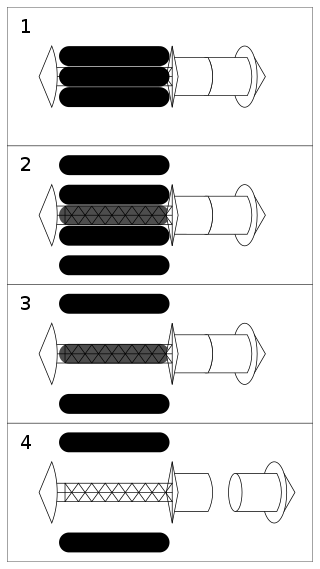
Interstellar travel is the hypothetical travel of spacecraft from one star system, solitary star, or planetary system to another. Interstellar travel is expected to prove much more difficult than interplanetary spaceflight due to the vast difference in the scale of the involved distances. Whereas the distance between any two planets in the Solar System is less than 55 astronomical units (AU), stars are typically separated by hundreds of thousands of AU, causing these distances to typically be expressed instead in light-years. Because of the vastness of these distances, non-generational interstellar travel based on known physics would need to occur at a high percentage of the speed of light; even so, travel times would be long, at least decades and perhaps millennia or longer.

Interplanetary spaceflight or interplanetary travel is the crewed or uncrewed travel between stars and planets, usually within a single planetary system. In practice, spaceflights of this type are confined to travel between the planets of the Solar System. Uncrewed space probes have flown to all the observed planets in the Solar System as well as to dwarf planets Pluto and Ceres, and several asteroids. Orbiters and landers return more information than fly-by missions. Crewed flights have landed on the Moon and have been planned, from time to time, for Mars, Venus and Mercury. While many scientists appreciate the knowledge value that uncrewed flights provide, the value of crewed missions is more controversial. Science fiction writers propose a number of benefits, including the mining of asteroids, access to solar power, and room for colonization in the event of an Earth catastrophe.

A fusion rocket is a theoretical design for a rocket driven by fusion propulsion that could provide efficient and sustained acceleration in space without the need to carry a large fuel supply. The design requires fusion power technology beyond current capabilities, and much larger and more complex rockets.

A nuclear explosive is an explosive device that derives its energy from nuclear reactions. Almost all nuclear explosive devices that have been designed and produced are nuclear weapons intended for warfare.

A starship, starcraft, or interstellar spacecraft is a theoretical spacecraft designed for traveling between planetary systems. The term is mostly found in science fiction. Reference to a "star-ship" appears as early as 1882 in Oahspe: A New Bible.

Nuclear pulse propulsion or external pulsed plasma propulsion is a hypothetical method of spacecraft propulsion that uses nuclear explosions for thrust. It originated as Project Orion with support from DARPA, after a suggestion by Stanislaw Ulam in 1947. Newer designs using inertial confinement fusion have been the baseline for most later designs, including Project Daedalus and Project Longshot.

A generation ship, or generation starship, is a hypothetical type of interstellar ark starship that travels at sub-light speed. Since such a ship might require hundreds to thousands of years to reach nearby stars, the original occupants of a generation ship would grow old and die, leaving their descendants to continue traveling.
Robert W. Bussard was an American physicist who worked primarily in nuclear fusion energy research. He was the recipient of the Schreiber-Spence Achievement Award for STAIF-2004. He was also a fellow of the International Academy of Astronautics and held a Ph.D. from Princeton University.

Project Orion was a study conducted in the 1950s and 1960s by the United States Air Force, DARPA, and NASA into the viability of a nuclear pulse spaceship that would be directly propelled by a series of atomic explosions behind the craft. Early versions of the vehicle were proposed to take off from the ground; later versions were presented for use only in space. The design effort took place at General Atomics in San Diego, and supporters included Wernher von Braun, who issued a white paper advocating the idea. Non-nuclear tests were conducted with models, but the project was eventually abandoned for several reasons, including the 1963 Partial Test Ban Treaty, which banned nuclear explosions in space, and concerns over nuclear fallout.

Nuclear propulsion includes a wide variety of propulsion methods that use some form of nuclear reaction as their primary power source. The idea of using nuclear material for propulsion dates back to the beginning of the 20th century. In 1903 it was hypothesized that radioactive material, radium, might be a suitable fuel for engines to propel cars, planes, and boats. H. G. Wells picked up this idea in his 1914 fiction work The World Set Free. Many aircraft carriers and submarines currently use uranium fueled nuclear reactors that can provide propulsion for long periods without refueling. There are also applications in the space sector with nuclear thermal and nuclear electric engines which could be more efficient than conventional rocket engines.

Project Daedalus was a study conducted between 1973 and 1978 by the British Interplanetary Society to design a plausible uncrewed interstellar probe. Intended mainly as a scientific probe, the design criteria specified that the spacecraft had to use existing or near-future technology and had to be able to reach its destination within a human lifetime. Alan Bond led a team of scientists and engineers who proposed using a fusion rocket to reach Barnard's Star 5.9 light years away. The trip was estimated to take 50 years, but the design was required to be flexible enough that it could be sent to any other target star.

Project Longshot was a conceptual interstellar spacecraft design. It would have been an uncrewed starship, intended to fly to and enter orbit around Alpha Centauri B powered by nuclear pulse propulsion.

An interstellar probe is a space probe that has left—or is expected to leave—the Solar System and enter interstellar space, which is typically defined as the region beyond the heliopause. It also refers to probes capable of reaching other star systems.

Spacecraft electric propulsion is a type of spacecraft propulsion technique that uses electrostatic or electromagnetic fields to accelerate mass to high speed and thus generate thrust to modify the velocity of a spacecraft in orbit. The propulsion system is controlled by power electronics.
The Valkyrie is a theoretical spacecraft designed by Charles Pellegrino and Jim Powell. The Valkyrie is theoretically able to accelerate to 92% the speed of light and decelerate afterward, carrying a small human crew to another star system.
Project Icarus is a theoretical engineering design study aimed at designing a credible, mainly nuclear fusion-based, unmanned interstellar space probe. Project Icarus was an initiative of members of the British Interplanetary Society (BIS) and the Tau Zero Foundation (TZF) started in 2009. The project was under the stewardship of Icarus Interstellar until 2019. It remains a BIS project.

The Enzmann starship is a concept for a crewed interstellar spacecraft proposed in 1964 by Dr. Robert Enzmann. A three million ton ball of frozen deuterium would fuel nuclear fusion rocket engines contained in a cylindrical section behind that ball with the crew quarters. The craft would be about 2,000 feet (600 m) long overall.
The Initiative for Interstellar Studies (i4is) is a UK-registered not-for-profit company, whose objectives are education and research into the challenges of Interstellar Travel. It pioneered small-scale laser sail interstellar probes and missions to interstellar objects. Several of its principals were involved in the 100 Year Starship winning team originated by NASA and DARPA.

Breakthrough Starshot is a research and engineering project by the Breakthrough Initiatives to develop a proof-of-concept fleet of light sail interstellar probes named Starchip, to be capable of making the journey to the Alpha Centauri star system 4.37 light-years away. It was founded in 2016 by Yuri Milner, Stephen Hawking, and Mark Zuckerberg.













